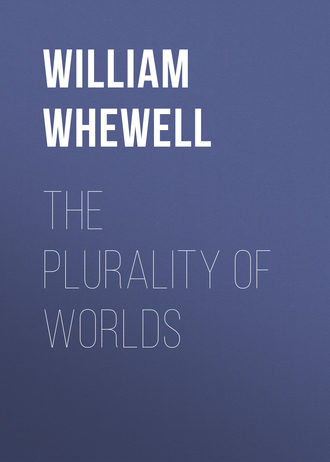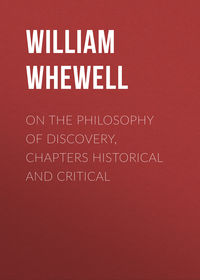 полная версия
полная версияThe Plurality of Worlds
42
Consolations in Travel. Dial. 1.
43
What is said in Art. 15, that in consequence of the time employed in the transmission of visual impressions, our seeing a star is evidence, not that it exists now, but that it existed, it may be, many thousands of years ago; may seem, to some readers, to throw doubts upon reasonings which we have employed. It may be said that a star which was a mere chaos, when the light, by which we see it, set out from it, may, in the thousands of years which have since elapsed, have grown into an orderly world. To which bare possibility, we may oppose another supposition at least equally possible:—that the distant stars were sparks or fragments struck off in the formation of the Solar System, which are really long since extinct; and survive in appearance, only by the light which they at first emitted.
44
More recently, at the meeting of the British Association in September, 1853, Professor Phillips has declared, that astronomers can discern the shape of a spot on the Moon's surface, which is a few hundred feet in breadth.
45
A person visiting the Eifel, a region of extinct volcanoes, west of the Rhine, can hardly fail to be struck with the resemblance of the craters there, to those seen in the moon through a telescope.
46
Bessel has discussed and refuted (it was hardly necessary) the conjecture of some persons (he describes them as "the feeling hearts who would find sympathy even in the Moon") that there may be in the Moon's valleys air enough to support life, though it does not rise above the hills.—Populäre Vorlesungen, p. 78.
47
The doctrine that the interior nucleus of the Earth is fluid, whether accepted or rejected, does not materially affect this argument. It appears, that in some cases, at least, the melting of substances is prevented, by their being subjected to extreme pressure; but the density, the element from which we reason, is measured by methods quite independent of such questions.
48
Herschel, 512. Bessel, however, holds that the oblateness of Jupiter proves that his interior is somewhat denser than his exterior. Pop. Vorles. p. 91.
49
Herschel, 513.
50
A difficulty may be raised, founded on what we may suppose to be the fact, as to the extreme cold of those regions of the Solar System. It may be supposed that water under such a temperature could exist in no other form than ice. And that the cold must there be intense, according to our notion, there is strong reason to believe. Even in the outer regions of our atmosphere, the cold is probably very many degrees below freezing, and in the blank and airless void beyond, it may be colder still. It has been calculated by physical philosophers, on grounds which seem to be solid, that the cold of the space beyond our atmosphere is 100° below zero. The space near to Jupiter, if an absolute vacuum, in which there is no matter to receive and retain heat emitted from the Sun, may, perhaps, be no colder than it is nearer the Sun. And as to the effect the great cold would produce on Jupiter's watery material, we may remark, that if there be a free surface, there will be vapor produced by the Sun's heat; and if there be air, there will be clouds. We may add, that so far as we have reason to believe, below the freezing point, no accession of cold produces any material change in ice. Even in the expeditions of our Arctic navigators, a cold of 40° below zero was experienced, and ice was still but ice, and there were vapors and clouds as in our climate. It is quite an arbitrary assumption, to suppose that any cold which may exist in Jupiter would prevent the state of things which we suppose.
51
Herschel, 508.
52
It may be thought fanciful to suppose that because there is little or no solid matter (of any kind known to us) in Jupiter, his animals are not likely to have solid skeletons. The analogy is not very strong; but also, the weight assigned to it in the argument is small. Valeat quantum valere debet.
53
Herschel, 522.
54
Herschel, 510.
55
According to Bessel, Schroeter once saw one bright point on the dark ground, near the boundary of light in Venus. This was taken as proving a mountain, estimated at 60,000 feet high. Pop. Vorles. p. 86.
56
Herschel, 509.
57
Other speculators also have regarded Saturn's Ring as a ring of cloud or water. See Cosmos, iii. 527 and 553.
58
Humboldt has already remarked (Cosmos, i. 95, and iii. 427), that the inner planets as far as Mars, and the outer ones beginning with Jupiter, form two groups having different properties. Also Encke. (See Humboldt's Note.)
59
Printed Oct. 19, 1853.
60
Herschel, 540.
61
It is probable, from the small density of Jupiter's satellites, that they also consist in a great measure of water and vapor. Only one of them is denser than Jupiter himself.—Cosmos.
62
It has, in our own day, even in the present year, been regarded as a great achievement of man to direct the fiery influences which he can command, so as to cast a colossal statue in a single piece, instead of casting it in several portions.
63
Herschel, 900-905.
64
Herschel, 901.
65
Besides the curious relation of the times of rotation of the planets, just noticed, there is another curious relation, of their distance from the Sun, which any one, wishing to frame an hypothesis on the origin of our Solar System, ought by all means to try to account for.
The distances from the Sun, of the planets, Mercury, Venus, Earth, Mars, the Planetoids, Jupiter, Saturn, Uranus, are nearly as the numbers,
4, 7, 10, 16, 28, 52, 100, 196:
now the excesses of each of these numbers above the first are,
3, 3, 6, 12, 24, 48, 96:
a series in which each term (after the first,) is double of the preceding one. Hence, the distances of the planets conform to a series following this law, (Bode's law, as it is termed.) And though the law is by no means exact, yet it was so far considered a probable expression of a general fact, that the deviation from this law, in the interval between Mars and Jupiter, was the principal cause which led first to the suspicion of a planet interposed in the seemingly vacant space; and thus led to the discovery of the planetoids, which really occupy that region. It is true, that the law is found not to hold, in the case of the newly-discovered planet Neptune; for his distance from the Sun, which according to this law, should be 388, is really only 300, 30 times the Earth's distance, instead of 39 times. Still, Bode's law has a comprehensive approximate reality in the Solar System, sufficient to make it a strong recommendation of any hypothesis of the origin of the system, that it shall account for this law. This, however, the nebular hypothesis does not.
66
The greatest anatomists, and especially Mr. Owen, have recently expressed their conviction, that researches on the structure of animals must be guided by the principle of unity of composition as well as the principle of final causes. See Owen On the Nature of Limbs.
67
This has been termed by physiologists The Law of the Development from the General to the Special.
68
Every reader of physiological works knows how easy it would be to multiply examples of this kind to any extent. Thus it is held by physiologists, that the sporules of fungi are universally diffused through the atmosphere, ready to vegetate whenever an opportunity presents itself: and that a single individual produces not less than ten millions of germs. It is held also that innumerable seeds of plants still capable of vegetation, lie in strata far below the earth's surface, finding the occasion to vegetate only by the rarest and most exceptional occurrences.—Carpenter, Manual of Physiology. 1851, Art. 44.
69
Chalmers, p. 35.
70
Ibid. p. 21
71
Ibid. p. 119.
72
Dr. Scoresby, in his Account of the Arctic Regions (1820) Vol. II. has given figures of 96 such forms, selected for their eminent regularity from many more.
73
Among the most recent expositors of this doctrine we may place M. Henri Martin, whose Philosophie Spiritualiste de la Nature is full of striking views of the universe in its relation to God. (Paris. 1849.)
74
Most readers who have given any attention to speculations of this kind, will recollect Newton's remarkable expressions concerning the Deity: "Æternus est et infinitus, omnipotens et omnisciens; id est, durat ab æterno in æternum, et adest ab infinito in infinitum.... Non est æternitas et infinitas, sed æternus et infinitus; non est duratio et spatium, sed durat et adest. Durat semper et adest ubique, et existendo semper et ubique durationem et spatium constituit."
To say that God by existing always and everywhere constitutes duration and space, appears to be a form of expression better avoided. Besides that it approaches too near to the opinion, which the writer rejects, that He is duration and space, it assumes a knowledge of the nature of the Divine existence, beyond our means of knowing, and therefore rashly. It appears to be safer, and more in conformity with what we really know, to say, not that the existence of God constitutes time and space; but that God has constituted man, so that he can apprehend the works of creation, only as existing in time and space. That God has constituted time and space as conditions of man's knowledge of the creation, is certain: that God has constituted time and space as results of his own existence in any other way, we cannot know.
75
"For doubt not that in other worlds aboveThere must be other offices of love,That other tasks and ministries there are,Since it is promised that His servants, there,Shall serve Him still."—Trench.76
For instance, we may assume that in two or three hundred years, by the improvement of telescopes, or by other means, it may be ascertained that the other planets of the Solar System are not inhabited, and that the other Stars are not the centres of regular systems.




